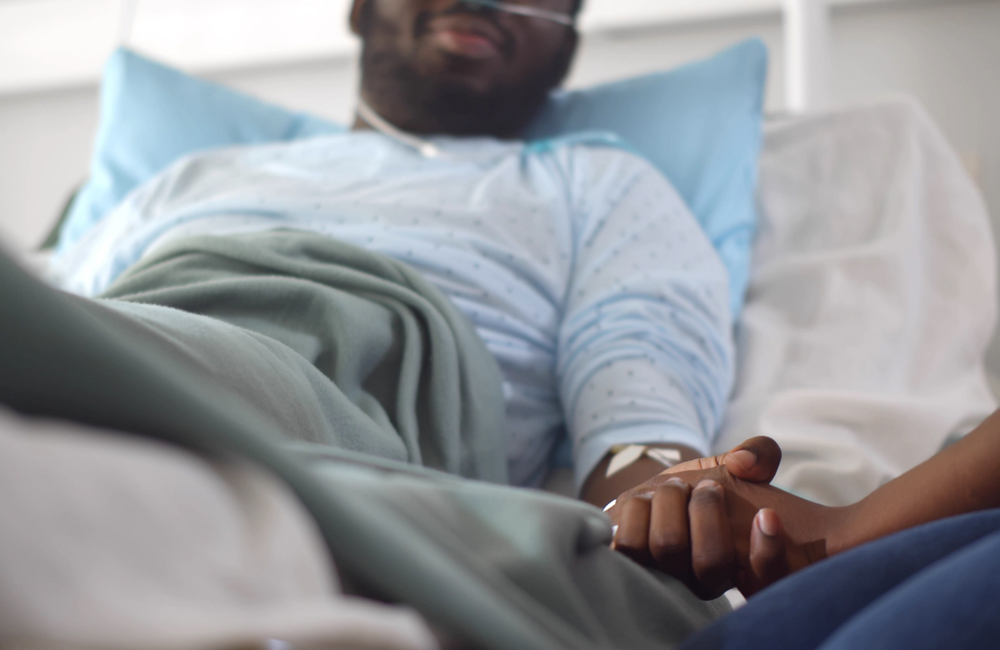
Two US studies show Black men with HIV have worse cancer outcomes than others. One study showed Black men with HIV have more than twice the risk of dying after diagnosis with Kaposi’s sarcoma compared to Hispanic men. The second study showed Black gay and bisexual men with HIV experienced anal cancer at rates 2.4 times higher than other men.
Though neither study pinpointed the reason for these disparities, both provide more evidence that Black people experience inequities in the US healthcare system.
Background
Racial disparities in the US surrounding PrEP use, antiretroviral therapy, and less consistent HIV care have been ongoing issues for years. The result is that, in 2019, Black Americans comprised just 13% of the US population but 42% of new HIV diagnoses and 43% of deaths. Furthermore, Black gay and bisexual men are more impacted by HIV than any other group in the US.
Black men have previously been found to have higher incidence rates and worse outcomes of Kaposi’s sarcoma and anal cancer. Kaposi’s sarcoma is caused by a virus called human herpes virus 8. Though antiretroviral therapy has significantly reduced both incidence and mortality of Kaposi’s sarcoma, it remains one of the most common cancers in people living with HIV. Anal cancer is a disease in which cancer cells are present just inside or immediately outside the anus. While incidence rates of anal cancer are generally low, rates are higher in people with HIV.
The studies
Dr Sheena Knights and colleagues investigated racial and ethnic differences in Kaposi’s sarcoma mortality, as well as the risk factors associated with death. The researchers reviewed medical records between 2009 and 2018 from a single hospital network that provides care to more than 6000 people with HIV in Dallas, Texas.
Their cohort included 262 people with Kaposi’s sarcoma, most of whom were men (95%) and gay or bisexual (78%). The group was ethnically diverse with about 35% Black people, 35% Hispanic people and about 30% White people.
Of the 262 people included, 81 (31%) died. The biggest risk factor for mortality from Kaposi’s sarcoma occurred in people hospitalised more than once within six months of cancer diagnosis, which carried a five-fold higher risk. People hospitalised once within six months and people who inject drugs both had nearly 2.5 times higher mortality risk than other people.
Black people had more than double the mortality risk compared to Hispanic people. This may be because Black people were diagnosed at more advanced stages of the disease: for example, 65% of Black people had wide-spread lesions (as opposed to localised), compared to 43% of Hispanic people, and 32% of White people.
Although the authors expected lower engagement with health care for Black people compared to others, their results indicated poor engagement across ethnicities. Less than 31% of people with Kaposi’s sarcoma, regardless of ethnicity, had two or more HIV clinical visits in the 12 months before they were diagnosed with the cancer. Furthermore, poor antiretroviral therapy adherence existed across ethnicities (32% of Black people included in the cohort were taking it compared to 30% of Hispanic people and 29% of White people). Accordingly, the percentage of people with CD4 counts below 50 was high (63% of Black people, 54% of Hispanic people, and 62% of White people). However, low CD4 count was not found to be a statistically significant mortality risk factor for Kaposi’s sarcoma.
Several other demographic factors did not affect mortality, including age when diagnosed with HIV or Kaposi’s sarcoma, being uninsured, experiencing unstable housing, having a history of tobacco use, or having a history of mental health issues.
The other study, by Dr Candace McNeil and colleagues, looked at anal cancer in gay and bisexual men with HIV. The researchers reviewed medical records between 1996 and 2014 from eight medical facilities across the US.
Their cohort included more than 7400 gay and bisexual men with HIV, 26% of whom were Black. In this analysis, the ethnicities of the rest of the men were reported only as non-Black (74%). They found the incidence rate of anal cancer in Black gay and bisexual men with HIV was 204 out of 10,000 people per year. For non-Black gay and bisexual men, the incidence rate was over three times lower at 61 out of 10,000 people per year.
After controlling for demographics, peak viral load, nadir CD4 count as well as behavioural factors such as smoking and drug injection, the researchers found Black gay and bisexual men with HIV were nearly 2.4 times more likely to get anal cancer than non-Black men.
Furthermore, 15 years after initiating antiretroviral therapy, the anal cancer incidence rate among Black gay and bisexual men was 4% compared to 1% for non-Black men.
Conclusion
Both sets of researchers recommended further work to identify root causes that could explain why Black men experienced inequities associated with cancer.
Knights and colleagues stated that higher mortality of Kaposi’s sarcoma could have been because Black people presented with more advanced stages when first diagnosed. Although the authors did not hypothesise why that occurred, it’s possible structural barriers impeded access to or affected the quality of health care the Black people in their cohort received.
Similarly, McNeil and colleagues did not identify a reason that incidence rates of anal cancer among Black gay and bisexual men increased so much more over time compared to non-Black men. However, they recommend more equitable programmes for HPV vaccination, HIV care, anal cancer prevention and anal cancer screening for Black gay and bisexual men.
Knights S et al. Mortality Disparities Among Patients with HIV-Associated Kaposi’s Sarcoma in the Southern United States AIDS, online ahead of print, 22 December 2021.
DOI: 10.1097/QAD.0000000000003155
McNeil C et al. Anal Cancer Incidence in MSM with HIV: Are Black men at higher risk? AIDS, online ahead of print, 17 December 2021.
DOI: 10.1097/QAD.0000000000003151
